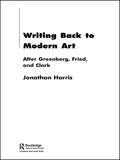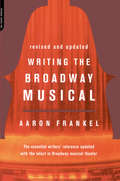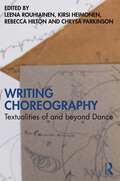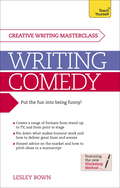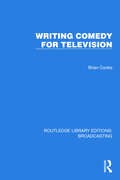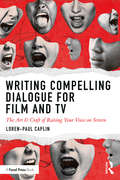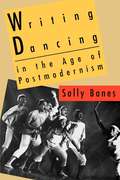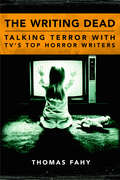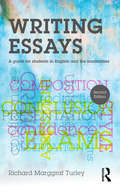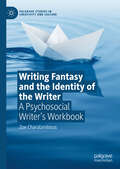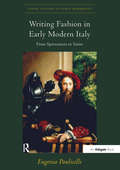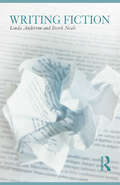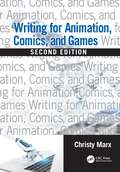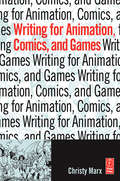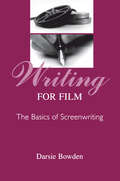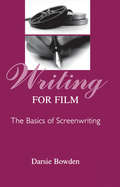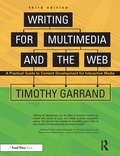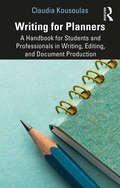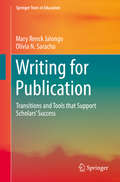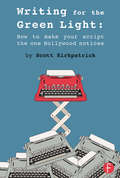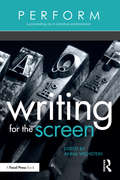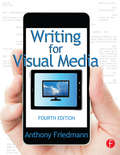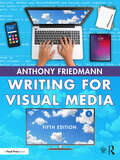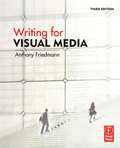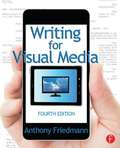- Table View
- List View
Writing Back to Modern Art: After Greenberg, Fried and Clark
by Jonathan HarrisHere for the first time is a full-length study of the 'critical modernisms' of the three leading art writers of the second half of the twentieth century, which helps us build a better understanding of the development of modern art writing and its relation to the 'post-modern' in art and society since the 1970s. Focusing on canonical modern artists such as Manet, Cezanne, Picasso and Pollock, this book provides an important understanding of writing and criticism in modern art for all students and scholars of art theory and art history. Mainstay issues discussed include aesthetic evaluation, subjectivity and meaning in art and art writing. Jonathan Harris examines key discourses and identifies points of significant overlap as well as sharp disjunction between the critics. Developing the notions of 'good' and 'bad' complexity in modernist criticism, Writing Back to Modern Art creates ways for us to think outside of these discourses of value and meaning and helps us to look at the place that art writing holds in the latter twentieth century and beyond.
Writing The Broadway Musical
by Aaron FrankelBrimming with advice and techniques, this essential reference for book- and songwriters clearly explains the fundamentals of the three crafts of a musical-book, music, and lyrics. Using copious examples from classic shows, Frankel has created the quintessential musical writers' how-to. Among the topics:definitions of musical theater; differences between musical books and straight plays and between poetry and lyrics; what a score is and how it develops; how to write for the voice; and how to audition musicals for producers. With a new introduction and revised text, Frankel's work is ready to guide a new generation of aspiring writers.
Writing Choreography: Textualities of and beyond Dance
by Leena Rouhiainen Kirsi Heimonen Rebecca Hilton Chrysa ParkinsonA new contribution to studies in choreography, Writing Choreography: Textualities of and beyond Dance focuses upon language and writing-based approaches to choreographing from the perspectives of artists and researchers active in the Nordic and Oceanic contexts.Through the contributions of 15 dance–artists, choreographers, dramaturges, writers, interdisciplinary artists and artist–researchers, the volume highlights diverse textual choreographic processes and outcomes arguing for their relevance to present-day practices of expanded choreography. The anthology introduces some Western trends related to utilizing writing, text and language in choreographic processes. In its focus on art-making processes, it likewise offers insight into how performance can be transcribed into writing, how practices of writing choreograph and how choreography can be a process of writing with. Readers, such as dancers, choreographers, students in higher education of these fields as well as researchers in choreography, gain understanding about different experimental forms of writing forwarded by diverse choreographers and how writing is the motional organisation of images, signs, words and texts. The volume presents a new strand in expanded choreography and acts as inspiration for its continued evolution that engenders new adaptations between language, writing and choreography.Ideal for students, scholars and researchers of choreography and dance studies.
Writing Comedy: How to use funny plots and characters, wordplay and humour in your creative writing
by Lesley BownLearn how to write comedy that makes people laugh.Masterclass: Writing Comedy will reveal to both beginners and experienced writers the distinctive features that mark out comedy from other forms of creative writing. Having identified these, it will help you then to unlock your inner anarchist, and explore the different elements of comedy, using a combination of practical exercises, insight and creative inspiration. Whatever your preferred comic genre, you will find guidance on everything from wordplay and visual humour to plots, comedy characters and different styles.A section on performance will help you to hone stand-up skills, while chapters on stage and screen will give techniques and tips on how to craft a sitcom or create a sketch show. Finally, there is a uniquely frank but useful section on the realities of the markets, and the actualities of going it alone with self-publishing and self-promotion - or the tools you need to successfully pitch an idea or comic manuscript.ABOUT THE SERIESThe Teach Yourself Creative Writing series helps aspiring authors tell their stories. Covering a range of genres from science fiction and romantic novels to illustrated children's books and comedy, this series is packed with advice, exercises, and tips for unlocking creativity and improving your writing. And because we know how daunting the blank page can be, we set up the Just Write online community, at tyjustwrite.com, for budding authors and successful writers to connect and share.
Writing Comedy for Television (Routledge Library Editions: Broadcasting #40)
by Brian CookeWriting Comedy for Television (1983) is a practical, step-by-step manual about how and what to write. It contains many examples from the scripts of various sitcoms and sketch shows. It demonstrates how to construct a storyline for a series, how to lay out a sketch, who to pitch to, and how a television comedy is put together.
Writing Compelling Dialogue for Film and TV: The Art & Craft of Raising Your Voice on Screen
by Loren-Paul CaplinWriting Compelling Dialogue for Film and TV is a practical guide that provides you, the screenwriter, with a clear set of exercises, tools, and methods to raise your ability to hear and discern conversation at a more complex level, in turn allowing you to create better, more nuanced, complex and compelling dialogue. The process of understanding dialogue writing begins with increasing writers’ awareness of what they hear. This book provides writers with an assortment of dialogue and language tools, techniques, and exercises and teaches them how to perceive and understand the function, intent and thematic/psychological elements that dialogue can convey about character, tone, and story. Text, subtext, voice, conflict, exposition, rhythm and style are among the many aspects covered. This book reminds us of the sheer joy of great dialogue and will change and enhance the way writers hear, listen to, and write dialogue, and along the way aid the writers’ confidence in their own voice allowing them to become more proficient writers of dialogue. Written by veteran screenwriter, playwright, and screenwriting professor Loren-Paul Caplin, Writing Compelling Dialogue is an invaluable writing tool for any aspiring screenwriter who wants to improve their ability to write dialogue for film and television, as well as students, professionals, and educators.
Writing Dancing in the Age of Postmodernism
by Sally BanesDrawing of the postmodern perspective and concerns that informed her groundbreaking Terpsichore in Sneakers, Sally Banes's Writing Dancing documents the background and developments of avant-garde and popular dance, analyzing individual artists, performances, and entire dance movements. With a sure grasp of shifting cultural dynamics, Banes shows how postmodern dance is integrally connected to other oppositional, often marginalized strands of dance culture, and considers how certain kinds of dance move from the margins to the mainstream.Banes begins by considering the act of dance criticism itself, exploring its modes, methods, and underlying assumptions, and examining the work of other critics. She traces the development of contemporary dance from the early work of such influential figures as Merce Cunningham and George Balanchine to such contemporary choreographers as Molissa Fenley, Karole Armitage, and Michael Clark. She analyzes the contributions of the Judson Dance Theatre and the Workers' Dance League, the emergence of Latin postmodern dance in New York, and the impact of black jazz in Russia. In addition, Banes explores such untraditional performance modes as breakdancing and the "drunk dancing" of Fred Astaire.Ebook Edition Note: Ebook edition note: All images have been redacted.
The Writing Dead: Talking Terror with TV'S Top Horror Writers (Television Conversations Series)
by Thomas FahyThe Writing Dead features original interviews with the writers of today's most frightening and fascinating shows. They include some of television's biggest names—Carlton Cuse (Lost and Bates Motel), Bryan Fuller (Hannibal, Dead Like Me, Wonderfalls, and Pushing Daisies), David Greenwalt (Angel and Grimm), Gale Anne Hurd (The Walking Dead, The Terminator series, Aliens, and The Abyss), Jane Espenson (Buffy the Vampire Slayer and Battlestar Galactica), Brian McGreevy (Hemlock Grove), Alexander Woo (True Blood), James Wong (The X-Files, Millennium, American Horror Story, and Final Destination), Frank Spotnitz (The X-Files and Millennium), Richard Hatem (Supernatural, The Dead Zone, and The Mothman Prophecies), Scott Buck (Dexter), Anna Fricke (Being Human), and Jim Dunn (Haven). The Writing Dead features thought-provoking, never-before-published interviews with these top writers and gives the creators an opportunity to delve more deeply into the subject of television horror than anything found online. In addition to revealing behind-the-scene glimpses, these writers discuss favorite characters and storylines and talk about what they find most frightening. They offer insights into the writing process reflecting on the scary works that influenced their careers. And they reveal their own personal fascinations with the genre. The thirteen interviews in The Writing Dead also mirror the changing landscape of horror on TV—from the shows produced by major networks and cable channels to shows made exclusively for online streaming services such as Netflix and Amazon Studios. The Writing Dead will appeal to numerous fans of these shows, to horror fans, to aspiring writers and filmmakers, and to anyone who wants to learn more about why we like being scared.
Writing Essays: A guide for students in English and the humanities
by Richard Marggraf TurleyEssays are a major form of assessment in higher education today and this is a fact that causes some writers a great deal of anxiety. Fortunately, essay writing is a skill that can be learned, like any other. Through precise explanations, this fully updated edition of Writing Essays gives you the confidence to express yourself coherently and effectively. It demystifies the entire process of essay writing, helping you to become proficient and confident in every aspect. Writing Essays reveals the tricks of the trade, making your student life easier. You’ll learn how to impress tutors by discovering exactly what markers look for when they read your work. Using practical examples selected from real student assignments and tutor feedback, this book covers every aspect of composition, from introductions and conclusions, down to presentation and submission. It also advises you on stress-free methods of revision, helps with exam essays, explains the principles of effective secondary source management, and shows you how to engage meaningfully with other critics’ views. A new chapter will also guide you through the intricacies of the undergraduate dissertation. As a full-time university professor, Richard Marggraf Turley counsels students and assesses their work every day, helping him to recognise the challenges that they face. Accessible, concise and full of practical examples, Writing Essays is a response to these challenges and will be an invaluable companion for Humanities students who wish to improve their grades and become confident in the art of essay writing.
Writing Fantasy and the Identity of the Writer: A Psychosocial Writer’s Workbook (Palgrave Studies in Creativity and Culture)
by Zoe CharalambousThis book presents the innovative pedagogy of Writing Fantasy: a method for exploring and shifting one’s identity as a writer. The book draws on qualitative research with undergraduate creative writing students and fills a gap in the literature exploring creative writing pedagogy and creative writing exercises. Based on the potential to shift writer identity through creative writing exercises and the common ground that these share with the stance of the Lacanian analyst, the author provides a set of guidelines, exercises and case studies to trace writing fantasy, evidenced in one’s creative writing texts and responses about creative writing. This innovative work offers fresh insights for scholars of creativity, Lacan and psychosocial studies, and a valuable new resource for students and teachers of creative writing.
Writing Fashion in Early Modern Italy: From Sprezzatura to Satire (Visual Culture in Early Modernity)
by Eugenia PaulicelliThe first comprehensive study on the role of Italian fashion and Italian literature, this book analyzes clothing and fashion as described and represented in literary texts and costume books in the Italy of the 16th and 17th centuries. Writing Fashion in Early Modern Italy emphasizes the centrality of Italian literature and culture for understanding modern theories of fashion and gauging its impact in the shaping of codes of civility and taste in Europe and the West. Using literature to uncover what has been called the ’animatedness of clothing,’ author Eugenia Paulicelli explores the political meanings that clothing produces in public space. At the core of the book is the idea that the texts examined here act as maps that, first, pinpoint the establishment of fashion as a social institution of modernity; and, second, gauge the meaning of clothing at a personal and a political level. As well as Castiglione’s The Book of the Courtier and Cesare Vecellio’s The Clothing of the Renaissance World, the author looks at works by Italian writers whose books are not yet available in English translation, such as those by Giacomo Franco, Arcangela Tarabotti, and Agostino Lampugnani. Paying particular attention to literature and the relevance of clothing in the shaping of codes of civility and style, this volume complements the existing and important works on Italian fashion and material culture in the Renaissance. It makes the case for the centrality of Italian literature and the interconnectedness of texts from a variety of genres for an understanding of the history of Italian style, and serves to contextualize the debate on dress in other European literatures.
Writing Fiction
by Linda Anderson Derek NealeWriting Fiction offers the novice writer engaging and creative activities, making use of insightful, relevant readings from well-known authors to illustrate the techniques presented. This volume makes use of new versions of key chapters from the recent Routledge/Open University textbook Creative Writing: A Workbook with Readings for writers who are specializing in fiction. Using their experience and expertise as teachers as well as authors, Linda Anderson and Derek Neale guide aspiring writers through such key aspects of writing as: how to stimulate creativity keeping a writer’s notebook character creation setting point of view structure showing and telling. The volume is further updated to include never-before published interviews with successful fiction writers Andrew Cowan, Stevie Davies, Maggie Gee, Andrew Greig, and Hanif Kureishi. Concise and practical, Writing Fiction offers an inspirational guide to the methods and techniques of authorship and is a must-read for aspiring writers.
Writing for Animation, Comics, and Games
by Christy MarxThis second edition of Writing for Animation, Comics, and Games expounds on the previous edition with more information on how to construct narratives for these three forms of visual storytelling media. Christy Marx’s book offers an in-depth look into scriptwriting and how to break into each of the featured industries. The text goes into detail on visual storytelling: how to compose exterior storytelling (animation, games) and interior/exterior storytelling (comics and graphic novels); as well as considerations for non-linear videogames. The advice within these pages can be used to build a transmedia career across animation, comics, graphic novels, and videogames. Key Features An insider's perspective on career rules of the road on writing for comics, videogames, and animation Written for beginners and professionals alike A nuts-and-bolts guide to script formats, terminology, networking, and valuable advice on writing for each medium Author Bio Based in Northern California, Christy Marx is an award-winning writer, story editor, TV series developer, game designer, and narrative designer. Her many credits include Babylon 5; Captain Power and Soldiers of the Future; The Twilight Zone; G.I. Joe; Jem and the Holograms; Spider-Man; He-Man; X-Men Evolution; Teenage Mutant Ninja Turtles; Conan the Adventurer; Birds of Prey; Amethyst; The Sisterhood of Steel; Sierra On-Line adventure games; PC, MMO, and console games; Zynga mobile games; and more. For full credits, visit www.christymarx.com.
Writing for Animation, Comics, and Games
by Christy MarxWriting for Animation, Comics, and Games explains the practical aspects of creating scripts for animation, comics, graphic novels, and computer games. It details how you can create scripts that are in the right industry format, and follow the expected rules for you to put your best foot forward to help you break-in to the trade. This book explains approaches to writing for exterior storytelling (animation, games); interior/exterior storytelling (comics and graphic novels), as well as considerations for non-linear computer games in the shortest, pithiest, and most economical way. The author offers insider's advice on how you can present work as professional, how to meet deadlines, how visual writing differs from prose, and the art of collaboration.
Writing for Film: The Basics of Screenwriting
by Darsie BowdenIn this introduction to screenwriting, author Darsie Bowden provides sage, real-world advice and instruction on the process of writing film screenplays. This text will help budding screenwriters to structure their dramas, refine their characterizations, and craft their language, while also introducing them to the appropriate screenplay formats. It covers the complexities of writing for the screen and points out the contradictions to expect if readers pursue this work as a career. In addition to covering the elements of the dramatic film screenplay, Bowden discusses writing for such "alternative" markets as documentaries, independent films, experimental films, and other non-Hollywood options. Features of the text include:guidelines for working as a screenwriter;applications and exercises to enhance skills;suggested readings for further development; anda comprehensive list of resources for screenwriting.Successful writing for film lies in being able to heighten one's perceptive abilities about the world and to communicate those perceptions in a cinematic way. In this text, Bowden introduces readers to an approach to screenwriting that will help them see the world in a different way and write about it using different genres and media. This most valuable skill prepares readers for the range of possibilities they will encounter on the path to successful screenwriting.
Writing for Film: The Basics of Screenwriting
by Darsie BowdenIn this introduction to screenwriting, author Darsie Bowden provides sage, real-world advice and instruction on the process of writing film screenplays. This text will help budding screenwriters to structure their dramas, refine their characterizations, and craft their language, while also introducing them to the appropriate screenplay formats. It covers the complexities of writing for the screen and points out the contradictions to expect if readers pursue this work as a career. In addition to covering the elements of the dramatic film screenplay, Bowden discusses writing for such "alternative" markets as documentaries, independent films, experimental films, and other non-Hollywood options. Features of the text include:guidelines for working as a screenwriter;applications and exercises to enhance skills;suggested readings for further development; anda comprehensive list of resources for screenwriting.Successful writing for film lies in being able to heighten one's perceptive abilities about the world and to communicate those perceptions in a cinematic way. In this text, Bowden introduces readers to an approach to screenwriting that will help them see the world in a different way and write about it using different genres and media. This most valuable skill prepares readers for the range of possibilities they will encounter on the path to successful screenwriting.
Writing for Multimedia and the Web: A Practical Guide to Content Development for Interactive Media
by Timothy GarrandLearning how to write for just one type of interactive media, such as web sites or games, is not enough! To be truly successful as an interactive writer or designer, you need to understand how to create content for all types of new media.Writing for Multimedia and the Web is the most comprehensive guide available for interactive writing. It covers web sites, computer games, e-learning courses, training programs, immersive exhibits, and much more. Earlier editions have garnered rave reviews as a writing handbook for multimedia and web professionals, as well as a classroom text for interactive writing and design.New Sections and Completely Updated Chapters:*Writing a corporate web site: T. Rowe Price*Creating blogs and podcasts*Web writing tips from usability experts*Optimizing text for web search engines*Defining the user with use cases and user scenarios*Dealing with web editors*Software for organizing and writing interactive media content*Script formats for all types of multimedia and web projects*Writing careers
Writing for Planners: A Handbook for Students and Professionals in Writing, Editing, and Document Production
by Claudia KousoulasWriting is never easy, but this book can make it easier. With attentiveness and experience, Claudia Kousoulas gives readers applied writing, editing, and production approaches that provide a clear path to completing a document and tools that ensure it is engaging and professional. The book follows a project’s path from initial assignment and conception, through sorting out what’s significant, shaping it into a message, and guiding readers to an action. It addresses the different types of documents planners have to create, the different media they use, and the different audiences they address. Its strategies will help writers start a project and see it through to a clear and coherent piece of work that serves its purpose. This book will help planners meet the challenges of creating work that is accurate, creative, and useful. Students will find it helpful in providing professional standards and quick reference information, and professionals will carry it through their careers as a reference, and as a way to establish workplace standards and improve their own work.
Writing for Publication
by Mary Renck Jalongo Olivia N. SarachoThis book offers systematic instruction and evidence-based guidance to academic authors. It demystifies scholarly writing and helps build both confidence and skill in aspiring and experienced authors. The first part of the book focuses on the author's role, writing's risks and rewards, practical strategies for improving writing, and ethical issues. Part Two focuses on the most common writing tasks: conference proposals, practical articles, research articles, and books. Each chapter is replete with specific examples, templates to generate a first draft, and checklists or rubrics for self-evaluation. The final section of the book counsels graduate students and professors on selecting the most promising projects; generating multiple related, yet distinctive, publications from the same body of work; and using writing as a tool for professional development. Written by a team that represents outstanding teaching, award-winning writing, and extensive editorial experience, the book leads teacher/scholar/authors to replace the old "publish or perish" dictum with a different, growth-seeking orientation: publish and flourish.
Writing for the Green Light: How to Make Your Script the One Hollywood Notices
by Scott KirkpatrickTailor your screenplay to sell. Find out what Hollywood script readers, producers, and studio executives want in a screenplay (and why) from someone who’s been there. Discover what it takes to begin a lasting career as a screenwriter. Peppered with interviews from established professionals, Writing for the Green Light: How to Make Your Script the One Hollywood Notices gives you a sharp competitive edge by showcasing dozens of everyday events that go on at the studios but are rarely if ever discussed in most screenwriting books. With his behind-the-scenes perspective, Scott Kirkpatrick shows you why the system works the way it does and how you can use its unwritten rules to your advantage. He answers such questions as: Who actually reads your script? How do you pique the interest of studios and decision makers? What do agents, producers, and production companies need in a script? How much is a script worth? What are the best genres for new writers and why? What are real steps you can take to ‘break in’ to television writing? How do you best present or pitch a project without looking desparate? How do you negotiate a contract without an agent? How do you exude confidence and seal your first deal? These and other insights are sure to give you and your screenplay a leg-up for success in this competitive landscape!
Writing for the Screen (PERFORM)
by Anna WeinsteinWriting for the Screen is a collection of essays and interviews exploring the business of screenwriting. This highly accessible guide to working in film and television includes perspectives from industry insiders on topics such as breaking in; pitching; developing and nurturing business relationships; juggling multiple projects; and more. Writing for the Screen is an ideal companion to screenwriting and filmmaking classes, demystifying the industry and the role of the screenwriter with real-world narratives and little-known truths about the business. With insight from working professionals, you’ll be armed with the information you need to pursue your career as a screenwriter. Contains essays by and interviews with screenwriting consultants, television writers, feature writers, writer-directors of independent film, producers, and professors. Offers expert opinions on how to get started, including preparing your elevator pitch, finding mentors, landing an internship, and moving from an internship to the next step in your career. Reveals details about taking meetings, what development executives are looking for in a screenwriter, how and when to approach a producer, and how to pitch. Explores strategies for doing creative work under pressure, finding your voice, choosing what to write, sticking with a project over the long haul, overcoming discrimination, and reinventing yourself as a writer. Illuminates the business of screenwriting in the United States (New York and Los Angeles) as compared to other countries around the globe, including England, Ireland, Peru, France, Australia, and Belgium.
Writing for Visual Media
by Anthony FriedmannThis updated edition of Writing for Visual Media will enable you to understand the nature of visual writing that lies behind the content of all visual media. This unique kind of writing must communicate to audiences through content producers, since audiences don't read the script. Most media content provides a solution to a communication problem, which the writer must learn to analyze and solve before writing the script. The Fourth Edition strengthens the method for creating content and writing in the correct language and established format for each visual medium, including commercial communication such as ads and PSAs, corporate communications, and training. An extended investigation into dramatic theory and how entertainment narrative works is illustrated by examples and detailed analysis of scenes, scripts and storylines, saving you designed to save writers from typical pitfalls and releasing your creative powers of invention. Writing for Visual Media will help you to develop an improved foundation for understanding interactive media and writing for non-linear content, while gaining the tools to effectively connect with your audience like a professional. Purchase of this book includes access to the companion website, which provides: Sample scripts and video clips of those produced scripts An interactive glossary of camera shots, movements, and transitions Storyboards, scripts, screenplays, and links to industry resource Instructor materials such as PowerPoint lecture slides, a sample syllabus, and a test bank. Visit the site at www.routledgetextbooks.com/textbooks/9780415815857
Writing for Visual Media
by Anthony FriedmannWriting for Visual Media provides writers with an understanding of the nature of visual writing behind all visual media. Such writing is vital for directors, actors, and producers to communicate content to audiences. Friedmann provides an extended investigation into dramatic theory and how entertainment narrative works, illustrated by examples and detailed analysis of scenes, scripts, techniques, and storylines. This new edition has a finger on the pulse of the rapidly evolving media ecosystem and explains it in the context of writing and creating content. Friedmann lays out many of the complex professional, creative, and commercial issues that a writer needs to understand in order to tell engaging stories and construct effective and professional screenplays. This new edition includes: A new chapter on storytelling A fresh examination of dramatic theory and how to apply it to constructing screenplays Updated discussion of mobile platforms A lengthened discussion of copyright, ethics, and professional development issues An updated companion website with sample scripts and corresponding videos, an interactive glossary, sample storyboards and screenplays, links to industry resources, and materials for instructors such as slides, a syllabus, and a test bank.
Writing for Visual Media (3rd Edition)
by Anthony FriedmannWriting for Visual Media looks at the fundamental problems a writer faces in learning to create content for media that is to be seen rather than read. It takes you from basic concepts to practice through a seven-step method that helps you identify a communications problem, think it through, and find a resolution before beginning to write. Through successive exercises, Writing for Visual Mediahelps you acquire the basic skills and confidence you need to write effective films, corporate and training videos, documentaries, web sites, PSAs, TV shows, nonlinear media, and other types of visual narratives. You'll explore your visual imagination and try out your powers of invention. The companion web site enriches the content of the printed book with video, audio, and sample scripts. It includes scripts and the video produced from them; visual demonstrations of concepts; and an interactive, illustrated glossary of terms and concepts.
Writing for Visual Media (Fourth Edition)
by Anthony FriedmannThis updated edition of Writing for Visual Media will enable you to understand the nature of visual writing that lies behind the content of all visual media. This unique kind of writing must communicate to audiences through content producers, since audiences don't read the script. Most media content provides a solution to a communication problem, which the writer must learn to analyze and solve before writing the script. The new edition strengthens the method for creating content and writing in the correct language and established format for each visual medium, including commercial communication such as ads and PSAs, corporate communications, and training. An extended investigation into dramatic theory and how entertainment narrative works is illustrated by examples and detailed analysis of scenes, scripts and storylines, saving you designed to save writers from typical pitfalls and releasing your creative powers of invention. Writing for Visual Media will help you to develop an improved foundation for understanding interactive media and writing for non-linear content, while gaining the tools to effectively connect with your audience like a professional. Purchase of this book includes access to the companion website, www. focalpress. com/cw/friedmann (coming June 5), which provides: Sample scripts and video clips of those produced scripts An interactive glossary of camera shots, movements, and transitions Storyboards, scripts, screenplays, and links to industry resource Instructor materials such as PowerPoint lecture slides, a sample syllabus, and a test bank.
